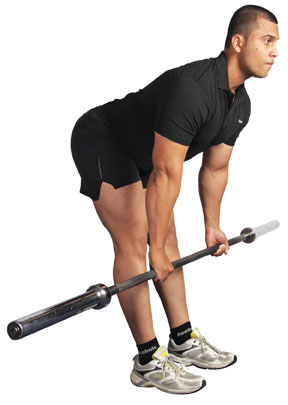Exercise Techniques
Like the site? Sign up for the FREE newsletter. I'll send a new article once or twice a month. Unsubscribe
anytime.
anytime.

About this Site l Contact l Free Newsletter l Subscribe to Rss Feed
Recommended Products l Fitness Store l Directly Fitness Blog
Recommended Products l Fitness Store l Directly Fitness Blog



HOW TO EXERCISE
Proper Exercise Technique:
Find this site useful? Click the donate button. Its greatly appreciated.
Think a friend might benefit from this page? Share it!
Think a friend might benefit from this page? Share it!
Note:
This is a complex movement and takes practice before attempting to move heavy weight. This movement can be mastered using only your own body weight first to avoid injury. When used correctly the stiff legged deadlift exercise can provide muscular strength in nearly all muscles and can be used as a lower back workout which is important to all aspects of fitness.
The injuries begin to happen when too much weight is used and it is important to note that you will be using a considerably lighter weight with this variation of deadlift. The stiff-legged deadlift or Romanian deadlift variation places most of the emphasis on the hamstrings and lower back. This type of deadlift should be used with higher repetitions and lighter weights than the Sumo and traditional deadlifts.
The legs are kept almost straight through the movement, with just a slight bend in the knees to take stress off the tendons and joints. You can initially lift the weight with the Traditional Deadlift form and then just bend over at the waist until you feel good stretch in the hamstrings and then straighten back up. Don't let the bar touch the floor in between repetitions. This will keep constant tension on the muscles at all times during the Stiff-Legged Deadlift.
with toes pointed out very slightly (approx. 5 degrees).
• Your shins should be touching or very close to the barbell.
• Squat down so you can comfortably grip the bar with arms remaining vertical.
• One hand should be using a supinated grip (palms up) while the other using
a pronated grip (overhand grip) OR you can use both hands pronated grip.
• Grip should be about shoulder width and outside your legs.
• Upper body and head should be straight with an upright posture and tight
abdominals.
• Your chest and buttocks should look as if you are sticking them out on
purpose.
• To avoid injury you can lift the bar up with the initial phase of the
Traditional Deadlift technique and then transition into the Romanian
technique.
and your arms.
• Drive your heels into the ground and contract your buttocks while extending
at the hips.
• There should be a slight bend that is constant throughout the movement but
no other motion at the knees. Do not let them flare out.
• Keep back flat or even slight arch in the small of your back, just don’t round
the back! This is the most common mistake and will inevitably lead to
injury.
• Abs should be contracted throughout the movement. This is important as it
will keep the pressure around your core tight. It is your “natural belt” which
mimics many common power lifting belts.
• As you begin to reach the end of the movement stop just before full
extension and do not lock out knees!
• You should feel your hamstrings begin to tense up.
• Knees should only have a slight bend and shouldn’t otherwise move. Do not
let them flare out.
• Keep back flat and do not round!
• Head and neck should be in line with your trunk.
• Slowly come to a halt before touching the ground if performing another
repetition.
• Movement is complete when weight touches the ground. Avoid dropping the
weight to the ground as this can damage the floor and very unpleasant to
fellow gym members.
must be learned before attempting this exercise! Try looking at yourself in
the mirror while practicing with no added weight.
• This is a high intensity exercise as almost every major muscle is being
worked! Be sure to have lots of energy and focus when performing the
deadlift.
• Be sure to inhale on the way down and exhale on the way up! If you hold
your breath in you risk passing out in the middle of the movement due to
built up pressure in your body!
• This exercise will feel very unnatural to some and most fail at forearm
strength.
• If you don’t have good forearm strength it won’t matter how strong your legs
and back are. Strength your forearms if you feel they can’t hold the bar
efficiently.
• Use lifting chalk if you feel your grip could use a little boost. You can find it at the Fitness
Store for great deals.
• If you progress to heavier sets, I recommend you use a belt to prevent injury
as it provides extra stability and support. I recommend you only use it for
those heavy sets as overusing a belt can actually lead to core weakness.
Simply do without the belt for lighter sets leading up to the heavy sets at which time you can put the belt on. This will keep you safe without having the core weakness associated with using a belt.
The best belts are the thick powerlifting style belts that are just as wide in the front as they are in the back. This allows you to push your stomach against the belt and provide more support for the lower back. I suggest you avoid the thin weight lifting belts that are pretty common in department stores. If you are interested in weight lifting belts you can find them in the Fitness Store.
About the Stiff-Legged Deadlift:
This exercise is involves the user to keep nearly straight legs without locking them out. If you have a history of back injury, it is recommended that you try one of the other variations of deadlift as this one will place the most stress on the lower back. As long as proper form is kept this exercise is actually quite safe.The injuries begin to happen when too much weight is used and it is important to note that you will be using a considerably lighter weight with this variation of deadlift. The stiff-legged deadlift or Romanian deadlift variation places most of the emphasis on the hamstrings and lower back. This type of deadlift should be used with higher repetitions and lighter weights than the Sumo and traditional deadlifts.
The legs are kept almost straight through the movement, with just a slight bend in the knees to take stress off the tendons and joints. You can initially lift the weight with the Traditional Deadlift form and then just bend over at the waist until you feel good stretch in the hamstrings and then straighten back up. Don't let the bar touch the floor in between repetitions. This will keep constant tension on the muscles at all times during the Stiff-Legged Deadlift.
Muscles Used in the Stiff-Legged Deadlift:
Exercises every major muscle group on your body, the same as the other two types of deadlifts. The stiff-legged deadlift tends to focus more emphasis to hamstrings and lower back as opposed to the "Sumo" and "Traditional Deadlifts".Starting Position:
• Begin by standing in front of a barbell on the ground, feet shoulder width,with toes pointed out very slightly (approx. 5 degrees).
• Your shins should be touching or very close to the barbell.
• Squat down so you can comfortably grip the bar with arms remaining vertical.
• One hand should be using a supinated grip (palms up) while the other using
a pronated grip (overhand grip) OR you can use both hands pronated grip.
• Grip should be about shoulder width and outside your legs.
• Upper body and head should be straight with an upright posture and tight
abdominals.
• Your chest and buttocks should look as if you are sticking them out on
purpose.
• To avoid injury you can lift the bar up with the initial phase of the
Traditional Deadlift technique and then transition into the Romanian
technique.
Upward Phase:
• Begin by contracting your traps and tensing the connection between the barand your arms.
• Drive your heels into the ground and contract your buttocks while extending
at the hips.
• There should be a slight bend that is constant throughout the movement but
no other motion at the knees. Do not let them flare out.
• Keep back flat or even slight arch in the small of your back, just don’t round
the back! This is the most common mistake and will inevitably lead to
injury.
• Abs should be contracted throughout the movement. This is important as it
will keep the pressure around your core tight. It is your “natural belt” which
mimics many common power lifting belts.
• As you begin to reach the end of the movement stop just before full
extension and do not lock out knees!
Downward Phase:
• Slowly lower the bar with your chest and buttocks sticking out.• You should feel your hamstrings begin to tense up.
• Knees should only have a slight bend and shouldn’t otherwise move. Do not
let them flare out.
• Keep back flat and do not round!
• Head and neck should be in line with your trunk.
• Slowly come to a halt before touching the ground if performing another
repetition.
• Movement is complete when weight touches the ground. Avoid dropping the
weight to the ground as this can damage the floor and very unpleasant to
fellow gym members.
Tips:
• This movement is very unnatural to most and will not come easily. Formmust be learned before attempting this exercise! Try looking at yourself in
the mirror while practicing with no added weight.
• This is a high intensity exercise as almost every major muscle is being
worked! Be sure to have lots of energy and focus when performing the
deadlift.
• Be sure to inhale on the way down and exhale on the way up! If you hold
your breath in you risk passing out in the middle of the movement due to
built up pressure in your body!
• This exercise will feel very unnatural to some and most fail at forearm
strength.
• If you don’t have good forearm strength it won’t matter how strong your legs
and back are. Strength your forearms if you feel they can’t hold the bar
efficiently.
• Use lifting chalk if you feel your grip could use a little boost. You can find it at the Fitness
Store for great deals.
• If you progress to heavier sets, I recommend you use a belt to prevent injury
as it provides extra stability and support. I recommend you only use it for
those heavy sets as overusing a belt can actually lead to core weakness.
Simply do without the belt for lighter sets leading up to the heavy sets at which time you can put the belt on. This will keep you safe without having the core weakness associated with using a belt.
The best belts are the thick powerlifting style belts that are just as wide in the front as they are in the back. This allows you to push your stomach against the belt and provide more support for the lower back. I suggest you avoid the thin weight lifting belts that are pretty common in department stores. If you are interested in weight lifting belts you can find them in the Fitness Store.
Here is a video to assist you in learning the proper form for stiff-legged deadlifts:
STIFF-LEGGED DEADLIFT
Continue to learn more about how to exercise: Proper Exercise Techniques
STIFF-LEGGED DEADLIFTS
